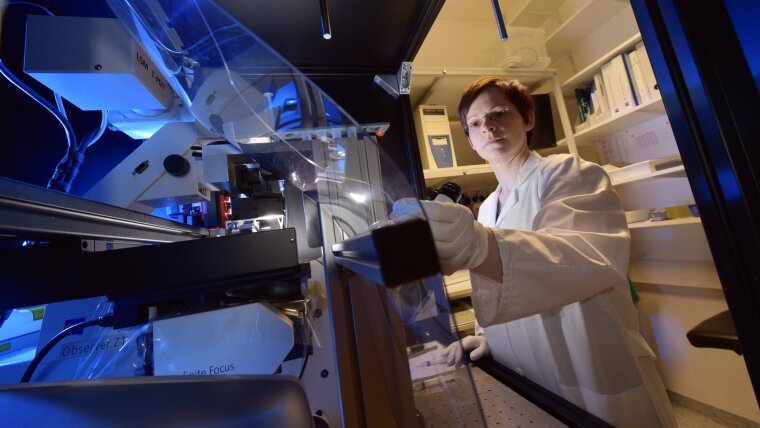
Erika KOTHE
Image: Anne Günther (University of Jena)Prof. Dr. Erika KOTHE
Email: erika.kothe@uni-jena.de
Phone: +49 3641-9-49291
Professor Kothe is, among other affiliations, speaker of the Graduate School Jena School for Microbial Communication within the Excellence-Cluster Balance of the Microverse. In addition, she is coordinator of the profile line LIFE of the Friedrich Schiller University Jena and president of the German University Association for Advanced Graduate Training.
Research Areas
With a particular focus on the visualization of morphological changes during mating interactions, her research interests are:
- Mating type genes and sexual development in the white rot fungus Schizophyllum commune
- Mutually beneficial symbiotic interactions of basidiomycetes in ectomycorrhizae
- Heavy-metal resistance in fungi and streptomycetes
- Applications to improve bioremediation
Teaching Fields
Professor Kothe teaches at the basic and advanced levels, including the coordination of the M.Sc. program Master‘s degree in Microbiology and she is involved in the Bachelor‘s and Master‘s degree programs in Biogeosciences. Additionally, she is involved in many graduate teaching programs. Subjects taught are:
- Basic and advanced microbiology
- Bio-geo-interactions
- High level microbial interactions, cell biology and development
Research Methods
The group offers all research-oriented teaching in the fields of microbiology and cell biology of bacteria and fungi. Nanostructures and minerals are covered with special emphasis on nanoparticles, biominerals and microbial investigation involving:
- Fluorescence video-imaging
- High resolution microscopy
- Omics techniques
- Characterization of mutations
- Characterization of native consortia
- High resultion imaging
Recent Research Results
The research on mating type loci covers pheromone response in mushroom forming fungi. We undertook a functional characterization and transcriptome analysis that enabled a comprehensive study of the mating reaction and intracellular signal transduction pathways involved [1]. Production of volatiles weathering of Corg-rich rock and wooden material, and the interaction with other fungi and bacteria is investigated using the model basidiomycete Schizophyllum commune [2].
Colonization strategies and host specificity of ectomycorrhizal fungi are examined with Tricholoma vaccinum. The sequenced genome of Tricholoma vaccinum and Agrobacterium tumefaciens mediated transformation enable functional analyses. The influence of co-occuring microorganisms on mycorrhiza is investigated [3], incluing heavy metal contaminated habitats.
Streptomycetes from a heavy metal containing site of the former uranium mining site Wismut in Eastern Thuringia are used to determine the mechanisms of heavy metal resistance in this group of important soil microbes and questions of bio-geointeractions [4,5]. The bacterial diversity is assessed for bioremediation approaches.
[1] Krause et al., PLoS ONE 15, e0232145 (2020).
[2] Murry et al., Adv. Biol. Regul. 72, 78 (2019).
[3] Wagner et al., Front. Microbiol. 10, 307 (2019).
[4] Burow et al., FEMS Microbiol. Lett. 366, fnz167 (2019).
[5] Krauße et al., J. Hazard. Mater. 370,1016 (2018).
link to the Microbial Communication Group
